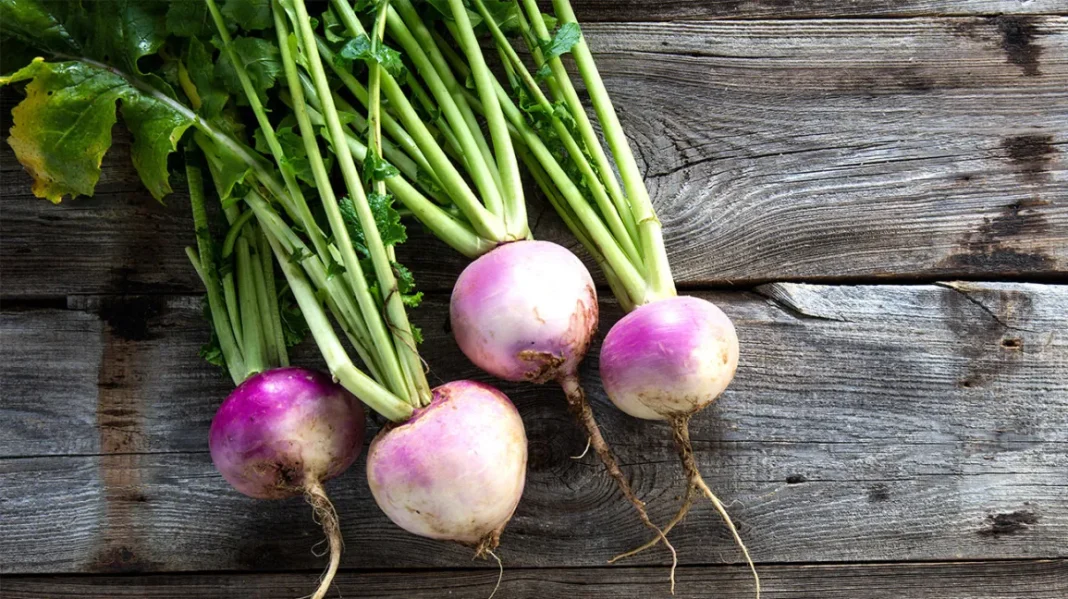Turnips (Brassicarapa) are a root vegetable and member of the cruciferous family, along with other vegetables like bok choy, Brussels sprouts, and kale.
They’re one of the world’s most important vegetable crops, as they’re used to feed both humans and cattle (1Trusted Source).
The most common types of turnip are purple, red, or greenish on the outside and have a white-fleshed bulb — also called the storage root or organ — which grows above the ground and has a smooth skin without scars or side roots (2Trusted Source).
Both their roots and leaves, also known as turnip greens, are safe to eat, and like most cruciferous vegetables, they’re praised for their health-promoting effects.
This article reviews turnips, including their nutritional content and health benefits.
Turnip nutrition
Turnips have an excellent nutritional profile.
Like other cruciferous vegetables, they’re low in calories but pack plenty of vitamins and minerals.
A 1-cup (130-gram) serving of cubed raw turnips contains:
- Calories: 36
- Carbs: 8 grams
- Fiber: 2 grams
- Protein: 1 gram
- Vitamin C: 30% of the Daily Value (DV)
- Folate: 5% of the DV
- Phosphorus: 3% of the DV
- Calcium: 3% of the DV
Nevertheless, the leaves contain even higher nutrient quantities, with 1 cup (55 grams) of chopped turnip greens providing:
- Calories: 18
- Carbs: 4 grams
- Fiber: 2 grams
- Vitamin K: 115% of the DV
- Vitamin C: 37% of the DV
- Provitamin A: 35% of the DV
- Folate: 27% of the DV
- Calcium: 8% of the DV
Both the roots and leaves are great sources of vitamin C, which protects your body from free radical damage when levels of these molecules become too high in the body.
This nutrient also improves iron absorption and helps regulate blood cholesterol, among many other health benefits (5Trusted Source).
Furthermore, turnip greens are rich in the fat-soluble vitamins K and A, the type that your body absorbs better when consumed with fats.
Vitamin K plays an essential role as a clotting agent, meaning that it helps prevent excessive bleeding. Plus, vitamin A is vital for eye, skin, and lung health (6Trusted Source, 7Trusted Source, 8Trusted Source, 9Trusted Source, 10Trusted Source).
Additionally, the leaves contain high amounts of folate, which aids the production of red blood cells and helps prevent developmental irregularities in fetuses (11Trusted Source, 12Trusted Source).
SUMMARY
Both turnips and turnip greens provide over 30% of the DV for vitamin C. Additionally, the greens are a great source of folate, vitamin K, and provitamin A.
Health benefits of turnips
Due to their nutritional composition, turnips — and turnip greens — offer many health-promoting effects.
May have anticancer properties
Turnips contain several beneficial plant compounds associated with cancer-fighting properties.
Besides their high vitamin C content, which may help prevent the growth and spread of cancer cells, turnips are rich in glucosinolates (5Trusted Source).
Glucosinolates are a group of bioactive plant compounds that also provide antioxidant activity, meaning they mitigate the cancer-promoting effects of oxidative stress (13Trusted Source, 14Trusted Source).
Numerous studies have linked higher intakes of glucosinolates with a reduced risk of different types of cancer, including lung, colon, and rectal cancers (15Trusted Source, 16Trusted Source, 17Trusted Source, 18Trusted Source).
Furthermore, turnips contain high amounts of flavonoids — mainly anthocyanins — another type of antioxidant with proven anticancer effects (13Trusted Source, 19Trusted Source).
Anthocyanins are present in blue and purple fruits and vegetables, such as turnips, and eating them is linked to lower rates of chronic and degenerative diseases (20Trusted Source, 21Trusted Source).
May help control blood sugar levels
Managing your blood sugar is critical for health, especially for those who have diabetes, and animal studies suggest that turnips may have antidiabetic effects.
One 9-month study in rats on a high sugar diet found that treatment with 45 mg of turnip extract per pound (100 mg per kg) of body weight lowered blood sugar levels and increased levels of insulin, compared with the control group (22Trusted Source).
The study also determined that the extract helped correct other metabolic disorders associated with diabetes, such as high blood cholesterol and triglyceride levels.
Similar results were found after testing the antidiabetic effects of turnip greens.
One 28-day study in rats with diabetes observed that those fed a daily dose of 90–180 mg of turnip leaf extract per pound (200–400 mg per kg) experienced significantly reduced blood sugar, as well as lower total and LDL (bad) cholesterol levels (23Trusted Source).
Both studies agree that the antidiabetic effects of turnip and turnip green extract may be due to multiple factors, including (13Trusted Source, 22Trusted Source, 23Trusted Source):
- increased blood sugar clearance
- lowered glucose (sugar) production by the liver
- reduced absorption of carbs
However, given that the studies only tested different types of extracts on rats, it’s unclear whether fresh turnip and turnip greens have similar effects in humans.
May provide anti-inflammatory effects
Inflammation is associated with many chronic diseases, such as arthritis, cancer, and high blood pressure caused by the hardening of the arteries.
Glucosinolates in turnips break down into indoles and isothiocyanates, both of which are bioactive byproducts with anti-inflammatory properties (13Trusted Source, 24Trusted Source).
One specific kind of indole in turnips is arvelexin, which studies suggest blocks pro-inflammatory compounds, such as nitric oxide, a type of free radical involved in the inflammation process (25Trusted Source, 26Trusted Source).
For example, test-tube and animal studies have found that arvelexin significantly reduced inflammation and injury in human colon cells and the colons of mice by inactivating an inflammatory pathway (27Trusted Source).
May protect against harmful bacteria
Turnips’ glucosinolates also break down into isothiocyanates, a group of compounds capable of inhibiting microbial and bacterial growth (13Trusted Source, 28Trusted Source).
Studies have found that isothiocyanates fight common disease-causing bacteria, such as E. coli and S. aureus (29Trusted Source).
One test-tube study determined that isothiocyanates from cruciferous vegetables had an antibacterial effect of up to 87% against antibiotic resistant strains of S. aureus (30Trusted Source).
Moreover, given the recent rise in cases of bacterial resistance, researchers have conducted test-tube and animal studies to evaluate the potential effect of combining isothiocyanates with standard antibiotics.
The results suggest that together, they may exert a more significant effect in controlling bacterial growth (29Trusted Source, 31Trusted Source).
Other potential health benefits
Turnip’s roots and greens may provide additional health benefits, including:
- May aid weight management. Turnips are low calorie, non-starchy vegetables with a low glycemic index, so eating them has a minimal effect on your blood sugar levels. According to research, these characteristics support a healthy weight (32Trusted Source, 33Trusted Source).
- May promote bone health. Vitamin K plays a key role in bone metabolism, and animal studies suggest that glucosinolates may positively affect bone formation (34Trusted Source, 35Trusted Source, 36Trusted Source).
- May protect your liver. Turnips’ content of anthocyanins and sulfur compounds, such as glucosinolates, have been shown to exert liver-protecting effects in rats with liver toxicity (13Trusted Source).
SUMMARY
Turnips’ vitamin and antioxidant contents may provide anti-inflammatory, anticancer, and antibacterial effects, among other benefits.
How to add turnips to your diet
Turnips can be eaten both cooked or raw, and turnip greens make a great addition to salads.
Here are some ways to incorporate turnips into your diet:
- Add some boiled turnips to your mashed potato recipe.
- Thinly slice and bake them to prepare crunchy turnip chips.
- Mix cubed turnips with potatoes and carrots when grilling or roasting vegetables.
- Add some grated turnips to coleslaw for a more flavorful version.
- Sauté turnips and turnip greens for a healthy side of veggies.
Turnips are very easy to cook with, and adding them to some of your favorite dishes will surely enhance their nutritional value.
SUMMARY
Turnip and turnip greens can be consumed in a variety of ways, and they pair nicely with multiple day-to-day recipes.
The bottom line
Turnips are a cruciferous vegetable with multiple health benefits.
They boast an impressive nutritional profile, and their bioactive compounds, such as glucosinolates, may support blood sugar control, protect against harmful bacteria, and provide anticancer and anti-inflammatory effects.
Both the roots and greens can be eaten and are quite nutritious, making them a great addition to a healthy diet.



